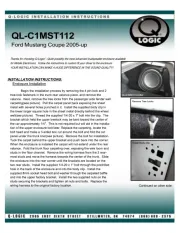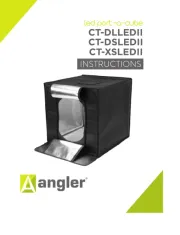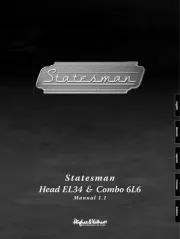Soma Ornament-8 Handleiding
Soma
Niet gecategoriseerd
Ornament-8
Bekijk gratis de handleiding van Soma Ornament-8 (28 pagina’s), behorend tot de categorie Niet gecategoriseerd. Deze gids werd als nuttig beoordeeld door 81 mensen en kreeg gemiddeld 4.6 sterren uit 41 reviews. Heb je een vraag over Soma Ornament-8 of wil je andere gebruikers van dit product iets vragen? Stel een vraag
Pagina 1/28

USER
MANUAL

ORNAMENT 8 USER MANUAL•
GENERAL REVIEW
ORNAMENT‑8 is an analog synthesizer of behavior for creating complex rhythmic patterns
and control signals. Since it inherits and further develops the principles laid down in the
LYRA•8 organismic synthesizer and the PULSAR•23 organismic drum machine, we called it
the “organismic sequencer”. The ORNAMENT is radically different from traditional sequencers
and is based on entirely different principles.
A regular music sequencer tends to produce user‑defined sequences of musical events (notes
and control parameters) that play at a given speed (tempo). Different sequencers differ
mainly in how this sequence of musical events is set and what modifications are possible. But
even in the most advanced and complex sequencers, there is still some memory containing
the given events which are reproduced at the given speed. This memory can contain many
options and patterns with a flexible system for switching between them and have various
playback algorithms, but the basic principle remains unchanged.
The fundamental difference of the ORNAMENT is that it has no clock generator and lacks
the very concept of tempo (playback speed). There is no memory that stores musical events
and there are no global control elements. Instead, we have a fully horizontal structure
consisting of 8 identical and equal cells. Each cell is a controlled delay line that receives a
pulse, which it holds for a certain time before it passes the pulse on. Each cell has two pulse
transmission modes, several control inputs and several outputs. By commutating cells (see
below for denition) in different ways, you create a dynamic structure in which pulses that
wander in the system are transmitted, added and subtracted, generating behavior that you
can transform into various musical events and controlling voltages.
We can say that the ORNAMENT is an electronic micro‑model of an anarchist society. When
you experiment with this system you can observe and explore the process of life arising
in incredible structures which have no discernable order other than the direct relations
between its equal members.
There is no Holy Book in which the events of the future are recorded. There is only the ever‑
present and continually arising “now” that ows and develops from moment to moment,
according to the relationships established within the system.
The ORNAMENT is similar to an organism where an ensemble of interacting organs cov‑
ered by various connections, generates the resulting behavior, which is a dynamic sum of
interactions. This behavior is not stored in any memory and does not follow directly from
the properties of individual organs, but is a meta-property of the system as a whole.
There is no main organ in the body, although for some time in some circumstances one of the
organs may turn out to be the leader and determine the behavior of the system. Similarly, in
ORNAMENT, in some patches, individual cells can have a dominant inuence on the system,
but this will always be a property of the patch, and not a unique property of the cell itself.

ORNAMENT 8USER MANUAL •
Depending on the switching scheme and settings, the ORNAMENT can generate both stable,
strictly repeating oscillations, and very complex, time-evolving sequences close to pseudo-
chaotic. The 100 percent analog nature of the ORNAMENT, sensitive to environmental
changes and the saturated life of the microworld, introduces an element of real chaos and
unpredictability into its behavior, which is especially evident when the system is not stable
and has many quasi‑stable states between which it can switch from the slightest changes
in the ow of pulses. In the extreme case, the ORNAMENT is able to generate entire com‑
positions with specic dramaturgy, pauses and developed structure.
The identical nature of the cells makes it possible to connect multiple ORNAMENTs to‑
gether, creating generative structures of 16, 32, etc. cells and, accordingly, more complex
and diverse behavior.
The external CV control feature allows external devices to control the behavior of the ORNA‑
MENT. We achieved interesting self-developing compositions when we combined PULSAR•23
and ORNAMENT with many connections, where both ORNAMENT controlled PULSAR and
PULSAR inuenced ORNAMENT.
In other words, the ORNAMENT offers vast possibilities of experimentation in the eld
of generative music. It’s a fully analog device, essentially an analog computer. On a more
philosophical level, ORNAMENT is an opportunity to learn about the fundamental laws that
govern our life, society and history by experimenting with a small device the size of a box
of chocolates.
The ORNAMENT works wonderfully with LYRA•8 and PULSAR•23, adding a new dimension
to them, and it can also control and manage Eurorack modules as well as anything that
can accept CV.
Product specificaties
| Merk: | Soma |
| Categorie: | Niet gecategoriseerd |
| Model: | Ornament-8 |
Heb je hulp nodig?
Als je hulp nodig hebt met Soma Ornament-8 stel dan hieronder een vraag en andere gebruikers zullen je antwoorden
Handleiding Niet gecategoriseerd Soma

8 April 2025

13 Juni 2023

17 Mei 2023

15 Mei 2023
Handleiding Niet gecategoriseerd
- Aston Microphones
- Woood
- Code Corporation
- Ameristep
- ICC
- MDT
- Medion
- Lexibook
- Trekstor
- Ziehl
- Extralink
- Eltako
- Croozer
- Shokz
- Fontiso
Nieuwste handleidingen voor Niet gecategoriseerd

18 September 2025

18 September 2025

18 September 2025

18 September 2025

18 September 2025

18 September 2025

18 September 2025

17 September 2025

17 September 2025

17 September 2025